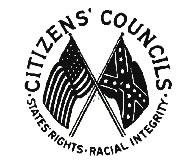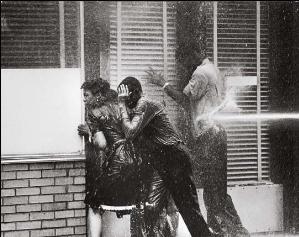
Medgar Wiley Evers was an American civil rights activist and soldier who was the NAACP's first field secretary in Mississippi. Evers, a United States Army veteran who served in World War II, was engaged in efforts to overturn racial segregation at the University of Mississippi, end the segregation of public facilities, and expand opportunities for African Americans, including the enforcement of voting rights when he was assassinated by Byron De La Beckwith.

The Congress of Racial Equality (CORE) is an African-American civil rights organization in the United States that played a pivotal role for African Americans in the civil rights movement. Founded in 1942, its stated mission is "to bring about equality for all people regardless of race, creed, sex, age, disability, sexual orientation, religion or ethnic background." To combat discriminatory policies regarding interstate travel, CORE participated in Freedom Rides as college students boarded Greyhound Buses headed for the Deep South. As the influence of the organization grew, so did the number of chapters, eventually expanding all over the country. Despite CORE remaining an active part of the fight for change, some people have noted the lack of organization and functional leadership has led to a decline of participation in social justice.

The Southern Christian Leadership Conference (SCLC) is an African-American civil rights organization based in Atlanta, Georgia. SCLC is closely associated with its first president, Martin Luther King Jr., who had a large role in the American civil rights movement.

A sit-in or sit-down is a form of direct action that involves one or more people occupying an area for a protest, often to promote political, social, or economic change. The protestors gather conspicuously in a space or building, refusing to move unless their demands are met. The often clearly visible demonstrations are intended to spread awareness among the public, or disrupt the goings-on of the protested organization. Lunch counter sit-ins were a nonviolent form of protest used to oppose segregation during the civil rights movement, and often provoked heckling and violence from those opposed to their message.

The Citizens' Councils were an associated network of white supremacist, segregationist organizations in the United States, concentrated in the South and created as part of a white backlash against the US Supreme Court's landmark Brown v. Board of Education ruling. The first was formed on July 11, 1954. The name was changed to the Citizens' Councils of America in 1956. With about 60,000 members across the Southern United States, the groups were founded primarily to oppose racial integration of public schools: the logical conclusion of the Brown v. Board of Education ruling.

The Greensboro sit-ins were a series of nonviolent protests in February to July 1960, primarily in the Woolworth store — now the International Civil Rights Center and Museum — in Greensboro, North Carolina, which led to the F. W. Woolworth Company department store chain removing its policy of racial segregation in the Southern United States. While not the first sit-in of the civil rights movement, the Greensboro sit-ins were an instrumental action, and also the best-known sit-ins of the civil rights movement. They are considered a catalyst to the subsequent sit-in movement, in which 70,000 people participated. This sit-in was a contributing factor in the formation of the Student Nonviolent Coordinating Committee (SNCC).

The Nashville sit-ins, which lasted from February 13 to May 10, 1960, were part of a protest to end racial segregation at lunch counters in downtown Nashville, Tennessee. The sit-in campaign, coordinated by the Nashville Student Movement and the Nashville Christian Leadership Council, was notable for its early success and its emphasis on disciplined nonviolence. It was part of a broader sit-in movement that spread across the southern United States in the wake of the Greensboro sit-ins in North Carolina.

The Birmingham campaign, also known as the Birmingham movement or Birmingham confrontation, was an American movement organized in early 1963 by the Southern Christian Leadership Conference (SCLC) to bring attention to the integration efforts of African Americans in Birmingham, Alabama.

Allen Cavett Thompson was an American politician in the state of Mississippi. Affiliated with the Democratic Party, he served in the Mississippi House of Representatives and as mayor of Jackson, Mississippi.
The Cambridge riots of 1963 were race riots that occurred during the summer of 1963 in Cambridge, a small city on the Eastern Shore of Maryland. The riots emerged during the Civil Rights Movement, locally led by Gloria Richardson and the local chapter of the Student Nonviolent Coordinating Committee. They were opposed by segregationists including the police.
The United League was an African-American social movement in Northern Mississippi established in 1978, during the height of Ku Klux Klan activity in America. The United League's president and founder, Alfred "Skip" Robinson, was moved to act against Klan activity and police brutality in the turbulent American South. Mr. Robinson was a brick mason by trade, but a charismatic preacher in practice. Through his leadership, the black communities of Northern Mississippi effectively tempered police beatings, organized citywide boycotts, prevented black land and property loss, urged armed defense among its members, and elected local blacks into political office.

Golden Asro Frinks was an American civil rights activist and a Southern Christian Leadership Conference (SCLC) field secretary who represented the New Bern, North Carolina SCLC chapter. He is best known as a principal civil rights organizer in North Carolina during the 1960s.
The Royal Ice Cream sit-in was a nonviolent protest in Durham, North Carolina, that led to a court case on the legality of segregated facilities. The demonstration took place on June 23, 1957 when a group of African American protesters, led by Reverend Douglas E. Moore, entered the Royal Ice Cream Parlor and sat in the section reserved for white patrons. When asked to move, the protesters refused and were arrested for trespassing. The case was appealed unsuccessfully to the County and State Superior Courts.
This is a timeline of the civil rights movement in the United States, a nonviolent mid-20th century freedom movement to gain legal equality and the enforcement of constitutional rights for people of color. The goals of the movement included securing equal protection under the law, ending legally institutionalized racial discrimination, and gaining equal access to public facilities, education reform, fair housing, and the ability to vote.

The sit-in movement, sit-in campaign, or student sit-in movement, was a wave of sit-ins that followed the Greensboro sit-ins on February 1, 1960, led by students at North Carolina Agricultural and Technical Institute (A&T). The sit-in movement employed the tactic of nonviolent direct action and was a pivotal event during the Civil Rights Movement.
Stanley Everett Branche was an American civil rights leader from Pennsylvania who worked as executive secretary in the Chester, Pennsylvania, branch of the National Association for the Advancement of Colored People (NAACP) and founded the Committee for Freedom Now (CFFN).
The Chester school protests were a series of demonstrations that occurred from November 1963 through April 1964 in Chester, Pennsylvania. The demonstrations aimed to end the de facto segregation of Chester public schools that persisted after the 1954 Supreme Court case Brown v. The Board of Education of Topeka. The racial unrest and civil rights protests were led by Stanley Branche of the Committee for Freedom Now (CFFN) and George Raymond of the National Association for the Advancement of Colored Persons (NAACP).
The Committee for Freedom Now (CFFN) was an American civil rights organization in Chester, Pennsylvania, that worked to end de facto segregation and improve the conditions at predominantly black schools in Chester. CFFN was founded in 1963 by Stanley Branche along with the Swarthmore College chapter of Students for a Democratic Society and Chester parents. From November 1963 to April 1964, CFFN and the Chester chapter of the NAACP, led by George Raymond, initiated the Chester school protests which made Chester a key battleground in the civil rights movement.
Prior to the civil rights movement in South Carolina, African Americans in the state had very few political rights. South Carolina briefly had a majority-black government during the Reconstruction era after the Civil War, but with the 1876 inauguration of Governor Wade Hampton III, a Democrat who supported the disenfranchisement of blacks, African Americans in South Carolina struggled to exercise their rights. Poll taxes, literacy tests, and intimidation kept African Americans from voting, and it was virtually impossible for someone to challenge the Democratic Party, which ran unopposed in most state elections for decades. By 1940, the voter registration provisions written into the 1895 constitution effectively limited African-American voters to 3,000—only 0.8 percent of those of voting age in the state.
The Savannah Protest Movement was an American campaign led by civil rights activists to bring an end to the system of racial segregation in Savannah, Georgia. The movement began in 1960 and ended in 1963.










